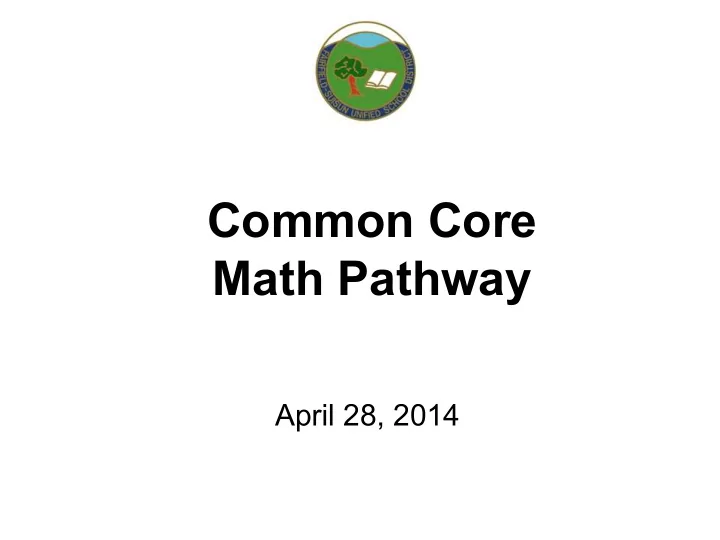

Common Core Math Pathway April 28, 2014
High School Mathematics Sequence Begin With The End In Mind CST Released Test Questions 1. What is 6050.287 rounded to the nearest ten? a. 6050 b. 6011 c. 6050.29 d. 6050.3 2. In a parking lot, 1 out of every 8 cars is blue. What percent of the cars in this lot are blue? a. 1.25% b. 7% c. 9% d. 12.5%
High School Mathematics Sequence Begin With The End In Mind ● Preparing students to be College and Career Ready ● Preparing students for the Smarter Balanced Assessments http://sampleitems.smarterbalanced. org/itempreview/sbac/index.htm
Mathematics Secondary Math Sequence Math 7/8 Math 1 (CP) PreCalculus OR AP Calculus Compacted Math 2 (CP) MS Math 7/8 OR AP Statistics OR IB Mathematics Math 3 (CP)
High School Mathematics Sequence Benefits of Math 1 (CP), Math 2 (CP), and Math 3 (CP) • The “real-life math” concept is an integration of algebra and geometry. • The integrated approach is consistent with how mathematics is taught in grades K-8, as well as supports the spiraling of the standards though Math 3 (CP). • According to a 2010 California colleges committee report, “A perception of mathematics as a unified field of study— students should see interconnections among various areas of mathematics, which are often perceived as distinct.” • The course build on the students’ mathematical knowledge to meet the rigorous demands of the Smarter Balanced Assessment.
NCEE Report (May, 2013) National Center on Education and the Economy http://www.ncee.org/college-and-work-ready/
NCEE Summary Findings: Career and College Ready 1. Many community college career programs demand little or no use of mathematics. To the extent that they do use mathematics, the mathematics needed by first year students in these courses is almost exclusively middle school mathematics. But the failure rates in our community colleges suggest that many of them do not know that math very well. A very high priority should be given to the improvement of the teaching of proportional relationships including percent, graphical representations, functions, and expressions and equations in our schools, including their application to concrete practical problems.
NCEE Summary Findings: Career and College Ready 2. It makes no sense to rush through the middle school mathematics curriculum in order to get to advanced algebra as rapidly as possible. Given the strong evidence that mastery of middle school mathematics plays a very important role in college and career success, strong consideration should be given to spending more time, not less, on the mastery of middle school mathematics, and requiring students to master Algebra I no later than the end of their sophomore year in high school, rather than by the end of middle school. This recommendation should be read in combination with the preceding one. Spending more time on middle school mathematics is in fact a recommendation to spend more time making sure that students understand the concepts on which all subsequent mathematics is based. It does little good to push for teaching more advanced topics at lower grade levels if the students’ grasp of the underlying concepts is so weak that they cannot do the mathematics. Once students understand the basic concepts thoroughly, they should be able to learn whatever mathematics they need for the path they subsequently want to pursue more quickly and easily than they can now.
Common Core Mathematics Sequence: When to accelerate? ● Decisions to accelerate students into the Common Core State Standards for higher mathematics before ninth grade should not be rushed. ● Decisions to accelerate students into higher mathematics before ninth grade must require solid evidence of mastery of prerequisite CCSSM. ● Compacted courses should include the same Common Core State Standards as the non-compacted courses. ● A menu of challenging options should be available for students after their third year of mathematics—and all students should be strongly encouraged to take mathematics in all years of high school. Source: California Department of Education
Common Core Mathematics – Compacted Course Content Math 7 Math 8 Math 1 (CP) ❑ Developing understanding ❑ Formulating and ❑ Extend understanding of of and applying reasoning about numerical manipulation to proportional relationships. expressions and algebraic manipulation. equations, including ❑ Developing understanding modeling an association ❑ Synthesize of operations with rational in bivariate data with a understanding of function. numbers and working with linear equation, and expressions and linear solving linear equations Deepen and extend ❑ equations. and systems of linear understanding of linear equations. relationships. ❑ Solving problems involving scale drawings Grasping the concept of a ❑ Apply linear models to ❑ and informal geometric function and using data that exhibit a linear constructions, and functions to describe trend. working with two- and quantitative relationships. three-dimensional shapes Establish criteria for ❑ to solve problems ❑ Analyzing two- and three- congruence based on involving area, surface dimensional space and rigid motions. area, and volume. figures using distance, angle, similarity, and Apply the Pythagorean ❑ ❑ Drawing inferences about congruence, and Theorem to the populations based on understanding and coordinate plane. samples. applying the Pythagorean Theorem.
Common Core Mathematics –Course Content Math 2 Math 3 (Includes Algebra and Geometry) (Includes Algebra 2 and Trigonometr y) ❑ Extend the laws of exponents to ❑ Apply methods from probability and rational exponents. statistics to draw inferences and conclusions from data. Compare key characteristics of ❑ quadratic functions with those ❑ Expand understanding of functions to of linear and exponential include polynomial, rational, and functions. radical functions. ❑ Create and solve equations and ❑ Expand right triangle trigonometry to inequalities involving linear, include general triangles. exponential, and quadratic expressions. Consolidate functions and geometry to ❑ create models and solve contextual Extend work with probability. problems. ❑ Establish criteria for similarity of ❑ triangles based on dilations and proportional reasoning.
Secondary Mathematics Sequence Support the Transition • Fairfield-Suisun Unified School District Common Core Website http://www.fsusd.org/Page/7125 • Common Core State Standards: Shifts for Parents and Students http://www.fsusd. org/cms/lib03/CA01001943/Centricity/Doma in/830/Shifts_Students_Parents.pdf
Common Core Math Pathway Comments - Questions Discussion
Recommend
More recommend